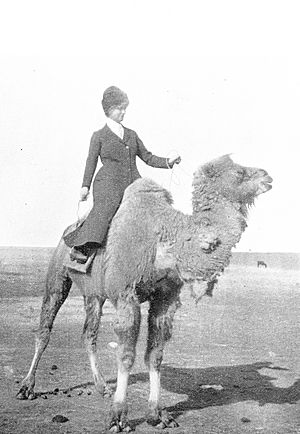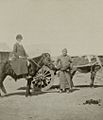Beatrix Bulstrode facts for kids
Beatrix Timbrell Bulstrode was a brave British journalist and explorer. She was born Mary Beatrix Nunns in 1869. Later, she was also known as Beatrix Manico Gull after her second marriage. She passed away in 1951. Beatrix is famous for her amazing trips through China and Mongolia in the early 1900s. She wrote all about her adventures in a book called A Tour in Mongolia, which came out in 1920.
Contents
Who Was Beatrix Bulstrode?
Beatrix was born in 1869 in a place called Sussex in England. As she grew up, she became a journalist. This means she wrote for newspapers and magazines. She was even part of a group called the Society of Woman Journalists.
In 1891, Beatrix married Herbert Timbrell Bulstrode. Sadly, he died in 1911. After this sad event, Beatrix decided she wanted to travel the world. She was ready for big adventures!
Beatrix's First Mongolian Journey
Beatrix traveled to Mongolia two times. Her first trip was with local guides. She also had a missionary from Finland with her. This journey was very exciting.
Beatrix was always prepared for anything. She carried a hidden Mauser C96 pistol. She was very good at using it. She also had two Colt revolvers and a shotgun. Her entire first journey cost her about $1,500.
Starting Her Travels in China
Beatrix began her big adventure in September 1911. She started in Hong Kong. First, she took a boat to Fuzhou. There, she explored the southern part of China.
Next, she took another boat trip. This boat went to the mouth of the Yangtze River. She then traveled about 1,200 miles (1,900 km) up the river. For part of the way, she was with a local crew. Later, she rode on a British steamer.
She traveled near a city called Yichang. Then, she went back to Hankou. From there, she traveled to the capital city, Beijing.
Journey to Mongolia
From Beijing, Beatrix traveled through Zhangjiakou. She rode in a cart to reach Mongolia. Once in Mongolia, she traveled about 120 miles (190 km) across open land. She met many Nomadic people along the way. These are people who move from place to place.
Beatrix decided not to cross the huge Gobi Desert. Instead, she returned to Beijing.
Beatrix's Second Mongolian Journey
Back in Beijing, Beatrix met Edward Manico Gull. He worked for customs in China. They decided to travel to northern Mongolia together. They felt they had good skills to help each other on the trip.
They took a train to Werkneudinsk in Siberia. Then, they traveled up the Selenga River on a steamboat. They arrived in Kyakhta. Here, Russian customs officials stopped them for a while. They were curious about Beatrix's weapons and ammunition.
Finally, they hired a special three-horse cart. It was called a taranta. They began their journey to the capital of Mongolia, Ulaanbaatar.
Experiences in Ulaanbaatar
In the capital, Beatrix visited a prison. She described seeing many prisoners there. They were kept in very small spaces. She also saw a public event where soldiers were punished.
Leaving the capital, they traveled by orton. They reached Kyakhta again. Then, they went back to Siberia. They rode the famous Trans-Siberian Railway to St. Petersburg. Finally, they returned home to Britain.
Her Book and Later Life
Beatrix published her book about her travels in 1920. It was called A Tour in Mongolia. The book starts with her stories from Beijing. The Washington Journal newspaper said her book was a "vivid account" of her journey.
Beatrix continued to help people in China. In 1937, she worked to provide relief work there. Beatrix Timbrell Bulstrode passed away in 1951 in Surrey, England.
Images for kids




